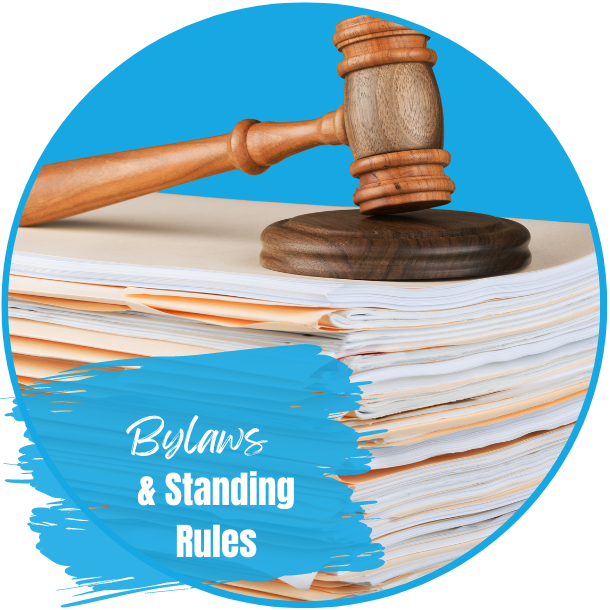Bylaws and Standing Rules
Bylaws are designed to help your PTA function in an orderly manner
The only official set of PTA bylaws for any PTA is an original approved current set of bylaws, signed and dated by the state parliamentarian, PTA president and secretary, and on file with the unit PTA secretary.
A copy of the association’s Bylaws for the Local PTA/PTSA Units must be made available to any association member upon request. A copy should be provided to all officers and board members. Each executive board member is responsible for making a thorough study of them.
If you need a current copy of approved bylaws contact your council first for assistance.
Bylaws vs Standing Rules
Standing rules outline the procedures of the organization that are not included in the bylaws and must not conflict with the bylaws or the California State PTA Toolkit. They may be changed or amended without notice with a two-thirds (2/3rd) majority vote of the association, or a majority vote with thirty (30) days’ notice.
Some of the differences between standing rules and bylaws are:
- Bylaws state when the meetings of the association are held.
- Standing rules tell where and what time association meetings are held, and when executive board meetings are held.
- Bylaws give the primary responsibilities of officers and chairmen.
- Standing rules give the specifics.
If the bylaws state that the first vice president is responsible for programs, the standing rules would list the various special committee chairmen who work under that vice president, such as Founders Day, Honorary Service Awards, etc. The bylaws describe the authority of committees. Standing rules indicate which committees are standing committees whose chairmen are voting members of the executive board and which committees are special committees, whose chairmen do not have executive board voting privileges and to which executive board member they report.
If the organization has supplies or equipment, the standing rules would state who is responsible for them and where they would be kept. They might also list details of the installation of officers, and who has responsibility for securing the past president’s pin.
Did You Know?
- California State PTA does not provide bylaws to units, councils, districts electronically.
- Unit, council or district bylaws should NOT be scanned or posted on any publically-accessible website.
- Bylaws always include officer signatures, which must be protected from inappropriate use.
- Bylaws should be reviewed annually, and updated every three years by the bylaws committee of the association, chaired by the parliamentarian.
- See CAPTA.org for much more information on bylaws
How to Update Your Bylaws
For Schools/Units
STEP 1
President – Appoints bylaws committee, chaired by parliamentarian
STEP 2
Parliamentarian – Sets meeting date for bylaws committee
- Review your current Bylaws prior to meeting
- Provide copies of current Bylaws for each bylaws committee member
STEP 3
Bylaws Committee – Reviews current Bylaws to see if any changes are necessary and lists proposed amendments, including article, section and page number
STEP 5
Executive Board – Parliamentarian presents updated Bylaws with proposed amendments at board meeting or recommends no changes.
- Board votes to approve
- Secretary records outcome in Minutes
STEP 6
Parliamentarian – Prints 3 double-sided copies of updated Bylaws, 4 blank Signature Pages & fills out the bylaws submittal form listing proposed amendments on page 2.
- Send all copies to your council
STEP 7
Bylaws returned – The California State PTA parliamentarian returns signed bylaws to the unit through district and council PTA channels.
STEP 8
Association Meeting – At an association meeting adopt the amendments to the bylaws.
- Members must be notified of the meeting at least thirty (30) days in advance and a list of the proposed amendments must be included with the notice.
- A two-thirds (2/3) vote of the association membership is required to adopt the amendments.
STEP 8
President & Secretary – After the association adopts the amendments, the president and secretary sign and date the master copy of the bylaws and the extra signature pages.
- Two signed signature pages are returned: one – to the council parliamentarian, and one – to the district PTA parliamentarian, to update their file copy.

